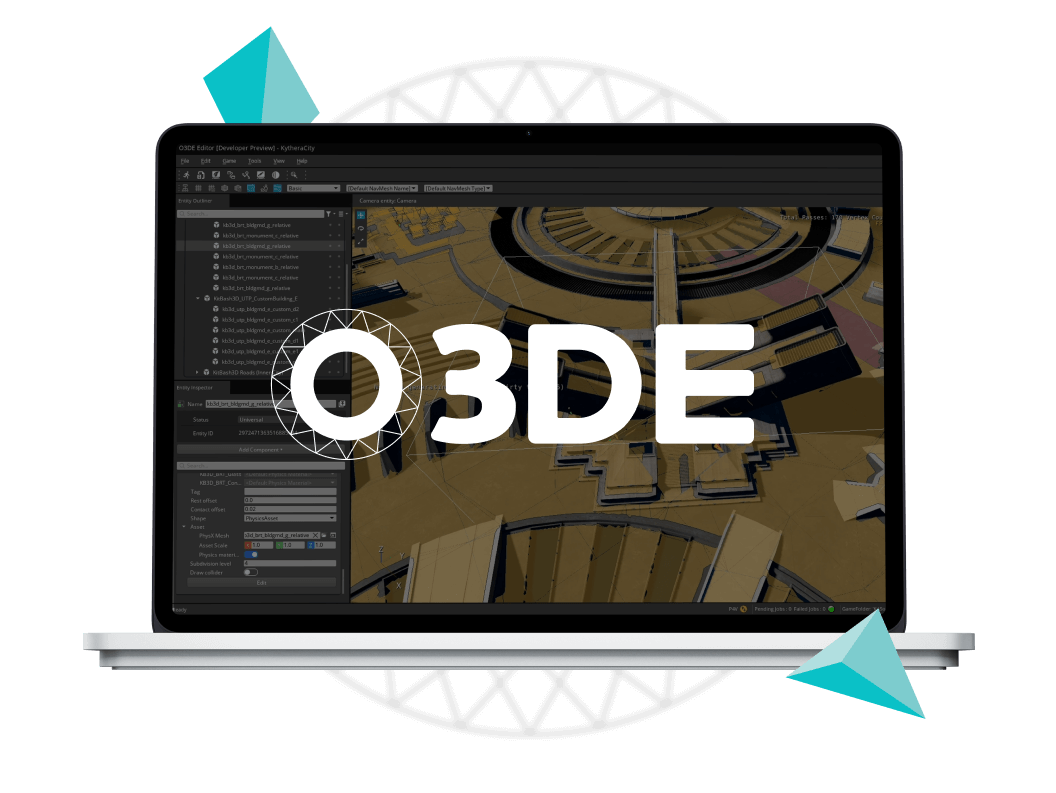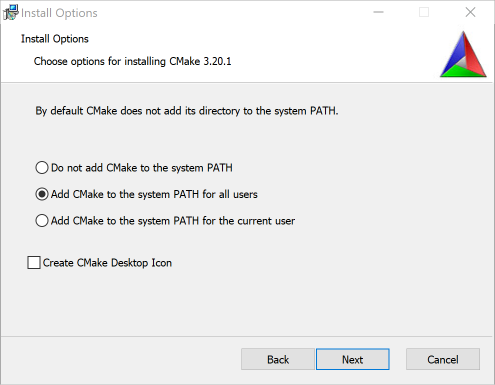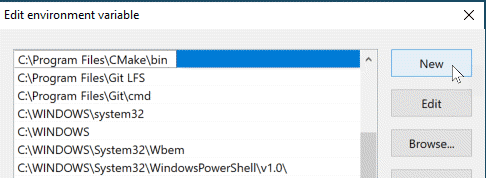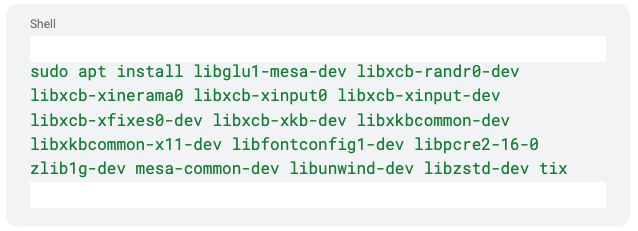O3DE Is Open Source & Free
Available for
Linux + Windows

Get the latest version 25.05.0
The latest version includes significant advancements, such as improved rendering performance by up to 40% due to subpass rendering support and a new shader constants feature. It also offers mature multi-GPU rendering support, Vertex Color support, and an automated XR installation process. Additionally, the Trackview (cinematics) has seen improvements in stability and ease of use.
VERSION UPDATES
- Improved rendering performance (up to 40%) thanks to subpass rendering support and new shader constants feature.
- Mature multi-gpu rendering support
- Vertex Color support
- Improved Trackview (cinematics) stability and ease of use
- Automated XR installation process
- Improved Android builds support
- SimulationInterfaces Gem: new Gem implementing standard ROS 2 simulation interfaces
- Asset Processor dependability improvements
- Reduced memory usage in editor and runtime environment
- Several multiplayer bug fixes and improvements
Minimum System Requirements
Minimum Hardware Specification
| Hardware Component | Minimum Required Specification |
| CPU | Quad-core (4 cores) 64-bit x86-capable Intel or AMD processor, 2.5 GHz, with the SSE 4.1 SIMD instruction set |
| RAM | 16 GB RAM (8GB RAM may be acceptable if you limit the number of threads used for compilation) |
| GPU | – DirectX 12 or Vulkan-compatible video card
– 2 GB VRAM – Shader Model 6.2 (or Shader Model 6.3 to use raytracing features) – NVIDIA GeForce GTX 1060, driver version 471.11 or later recommended or – AMD Radeon Pro 560 or – Intel HD 630 |
| Hard Disk | 40 GB (using the pre-built installer ) or 100+ GB (depending on project configuration) of free disk space |
| Display Device | 1366 x 768 pixel screen resolution |
Recommended Hardware Specifications
| Hardware Component | Minimum Recommended Specification |
| CPU | Hexa-core (6 cores) 64-bit x86-capable Intel or AMD processor, 2.5 GHz, supports the SSE 4.1 SIMD instruction set |
| RAM | 32 GB RAM |
| GPU | – DirectX 12 or Vulkan-compatible video card
– 6 GB VRAM – Shader Model 6.2 (or Shader Model 6.3 to use raytracing features) – NVIDIA GeForce GTX 16 Series, driver version 471.11 or later recommended or – AMD RX 5000 Series |
| Hard Disk | SSD with 1 TB of free disk space |
| Display Device | 1366 x 768 pixel screen resolution |
Software Prerequisties and Configuration
Creating new projects or using the advanced development features of O3DE requires several software components depending on the operating system you are using.
Microsoft Windows
At this time, Microsoft Windows is the primary platform for using the O3DE editor and for building source. Specifically, Windows 10 version 20H2 (10.0.19042) or later is required.
Microsoft Visual Studio
The following versions of Visual Studio are supported:
- Microsoft Visual Studio 2019 version 16.11.x.
- Microsoft Visual Studio 2022 version 17.3.x.
You can use any Microsoft Visual Studio license, including the Community edition. In addition, Windows 10 SDK version at 10.0.19041.0 or later is required.
Visual Studio Configuration
The default Visual Studio installation might not include all of the features that are required by O3DE. The following steps describe how to ensure that the necessary Visual Studio features are enabled:
- Launch the Visual Studio Installer.
- Choose Modify on the version of Visual Studio that you’ll use with O3DE.
- Note: Make sure you are modifying an installation of Visual Studio [Community, Enterprise, Professional] and not a different product, such as Visual Studio Build Tools.
- On the Workloads tab:
- Select Game development with C++.
- In the Installation details panel on the right, select a Windows 10 SDK version at 10.0.19041.0 or later.
- Select Desktop development with C++.
- Once you’ve completed your changes, choose the Install button in the lower right hand corner, selecting your preferred download option.
- Note: If you’ve made changes to an existing installation, you might see a Modify button in the lower right corner of the options window instead.
After the install completes, you might be prompted to restart your system.
Microsoft Visual Studio C++ Redistributable
You will also need the latest version of Visual C++ Redistributable for Visual Studio , if it was not installed by the Desktop development with C++ workload for Visual Studio.
After installing the C++ redistributable, you might be prompted to restart your system.
CMake
CMake 3.22.0 or later is required to configure and build O3DE projects. We strongly recommend that you install the Latest Release from the CMake download page instead of a Release Candidate. During installation, select one of the options that adds CMake to the system PATH. This will save you from having to do this later.

CMake configuration validation
Several O3DE CLI scripts require the cmake.exe command line tool to be available from a command line window. To see if this tool is on the system path, open a command prompt and use the –version command.

If the current CMake version was not returned because CMake cannot be found, locate the bin folder in the CMake installation directory and add the path to that folder to the front of your Windows system PATH environment variable by doing the following:
- Open the Windows Start menu.
- Type “env” to search for environment variables. Choose Edit system environment variables.
- Choose the Environment Variables button.
- Select Path under System variables.
- Choose the Edit… button.
- Choose New to add a new path to the list and enter the full path to the CMake bin folder.

- (Recommended) Choose Move Up to move the path to the top of the list.
- Choose OK to save your changes and close the windows that were opened.
- Verify that cmake is on the system path by opening a new command line window and running cmake –version again.
VERSION UPDATES
- Improved rendering performance (up to 40%) thanks to subpass rendering support and new shader constants feature.
- Mature multi-gpu rendering support
- Vertex Color support
- Improved Trackview (cinematics) stability and ease of use
- Automated XR installation process
- Improved Android builds support
- SimulationInterfaces Gem: new Gem implementing standard ROS 2 simulation interfaces
- Asset Processor dependability improvements
- Reduced memory usage in editor and runtime environment
- Several multiplayer bug fixes and improvements
Customise your engine
Looking to dive deep into O3DE?
Get the engine sources, build O3DE, and start working with the code now.
HELPFUL RESOURCES
Download O3DE, follow the installation instructions, watch the videos below, and start interacting with our awesome community.
Prerequisites of O3DE
Read up on the hardware and platform requirements to build and run O3DE.
Setting up O3DE from GitHub
For the Developer Preview, follow these instructions closely. Save yourself a few early adopter headaches!
Install O3DE for Windows
Learn how to install O3DE for Windows 64-bit.
Setup Troubleshooting
Rarely do things go perfectly. Check out our initial troubleshooting advice, or contribute your own tips!
Get the latest version 25.05.0
The latest version includes significant advancements, such as improved rendering performance by up to 40% due to subpass rendering support and a new shader constants feature. It also offers mature multi-GPU rendering support, Vertex Color support, and an automated XR installation process. Additionally, the Trackview (cinematics) has seen improvements in stability and ease of use.
VERSION UPDATES
- Improved rendering performance (up to 40%) thanks to subpass rendering support and new shader constants feature.
- Mature multi-gpu rendering support
- Vertex Color support
- Improved Trackview (cinematics) stability and ease of use
- Automated XR installation process
- Improved Android builds support
- SimulationInterfaces Gem: new Gem implementing standard ROS 2 simulation interfaces
- Asset Processor dependability improvements
- Reduced memory usage in editor and runtime environment
- Several multiplayer bug fixes and improvements
Minimum System Requirements
Minimum Hardware Specification
| Hardware Component | Minimum Required Specification |
| CPU | Quad-core (4 cores) 64-bit x86-capable Intel or AMD processor, 2.5 GHz, with the SSE 4.1 SIMD instruction set |
| RAM | 16 GB RAM (8GB RAM may be acceptable if you limit the number of threads used for compilation) |
| GPU | – DirectX 12 or Vulkan-compatible video card
– 2 GB VRAM – Shader Model 6.2 (or Shader Model 6.3 to use raytracing features) – NVIDIA GeForce GTX 1060, driver version 471.11 or later recommended or – AMD Radeon Pro 560 or – Intel HD 630 |
| Hard Disk | 40 GB (using the pre-built installer ) or 100+ GB (depending on project configuration) of free disk space |
| Display Device | 1366 x 768 pixel screen resolution |
Recommended Hardware Specifications
| Hardware Component | Minimum Recommended Specification |
| CPU | Hexa-core (6 cores) 64-bit x86-capable Intel or AMD processor, 2.5 GHz, supports the SSE 4.1 SIMD instruction set |
| RAM | 32 GB RAM |
| GPU | – DirectX 12 or Vulkan-compatible video card
– 6 GB VRAM – Shader Model 6.2 (or Shader Model 6.3 to use raytracing features) – NVIDIA GeForce GTX 16 Series, driver version 471.11 or later recommended or – AMD RX 5000 Series |
| Hard Disk | SSD with 1 TB of free disk space |
| Display Device | 1366 x 768 pixel screen resolution |
Software prerequisites and configuration
Creating new projects or using the advanced development features of O3DE requires several software components depending on the operating system you are using.
Linux
The primary Linux distribution for using the O3DE Editor is Ubuntu 22.04 LTS.
Note: Support for Ubuntu 24.04 LTS and Ubuntu on 64-bit ARMv8 processors is in an experimental stage.
The following instructions describe how to retrieve and install the required software packages through Ubuntu’s apt command-line utility.
CMake
As with the other operating systems, CMake 3.22.0 or later is required to configure and build O3DE projects. We strongly recommend that you install the Latest Release of CMake rather than the default one provided by your current Linux distribution. If CMake is already installed, but does not match the minimum version, you will need to remove it with the following command.

Install CMake using the instructions for the version of Ubuntu that you have installed:
You can install the default version of CMake for Ubuntu 22.04 LTS, which is version 3.22. To install more recent versions, refer to the CMake download page.

Once installed, verify that the version meets the minimum version criteria.
Clang
O3DE requires Clang 12 or later and the GNU C++ Library to compile all of the native C++ code.
Install Clang and the GNU C++ Library using the instructions for the version of Ubuntu that you have installed:
You can install the default version of Clang for Ubuntu 22.04 LTS, which is clang-14. You will also need to install the corresponding GNU C++ Library.
Vulkan supported video drivers
In addition to the minimum hardware requirements for video cards for O3DE, Linux requires that the latest drivers for the video card are installed and enabled. Refer to the video card manufacturer’s support page for instructions on how to do this.
Additional library dependencies
O3DE also requires some additional library packages to be installed:
- libglu1-mesa-dev
- libxcb-randr0-dev
- libxcb-xinerama0
- libxcb-xinput0
- libxcb-xinput-dev
- libxcb-xfixes0-dev
- libxcb-xkb-dev
- libxkbcommon-dev
- libxkbcommon-x11-dev
- libfontconfig1-dev
- libpcre2-16-0
- zlib1g-dev
- mesa-common-dev
- libstdc++-12-dev
- libunwind-dev
- libzstd-dev
- tix
You can download and install these packages through apt.
Ninja Build System (Optional)
By default, CMake uses Unix Makefiles for building O3DE. O3DE supports multiple build configurations (debug, profile, and release), which you specify when building O3DE. Unix Makefiles only supports single-configuration builds, so you must determine which configuration you want to build when you generate the project. All project builds are based on that configuration. In order to change the build configuration, you need to regenerate the project with the different configuration. This process restricts O3DE’s support for multiple-configuration builds and slows down building workflows.
The Ninja build system is an alternative to Linux’s default Unix Makefiles. The Ninja build system makes it easier to generate, configure, and build your project. With the Ninja build system, specifically Ninja Multi-Config , you can generate the project once and determine which configuration to build during build time. We recommend that you use this generator for O3DE development. You can install the Ninja build tool through apt.

VERSION UPDATES
- Improved rendering performance (up to 40%) thanks to subpass rendering support and new shader constants feature.
- Mature multi-gpu rendering support
- Vertex Color support
- Improved Trackview (cinematics) stability and ease of use
- Automated XR installation process
- Improved Android builds support
- SimulationInterfaces Gem: new Gem implementing standard ROS 2 simulation interfaces
- Asset Processor dependability improvements
- Reduced memory usage in editor and runtime environment
- Several multiplayer bug fixes and improvements
Customise your engine
Looking to dive deep into O3DE?
Get the engine sources, build O3DE, and start working with the code now.
HELPFUL RESOURCES
Download O3DE, follow the installation instructions, watch the videos below, and start interacting with our awesome community.
Prerequisites of O3DE
Read up on the hardware and platform requirements to build and run O3DE.
Setting up O3DE from GitHub
For the Developer Preview, follow these instructions closely. Save yourself a few early adopter headaches!
Install O3DE for Windows
Learn how to install O3DE for Windows 64-bit.
Setup Troubleshooting
Rarely do things go perfectly. Check out our initial troubleshooting advice, or contribute your own tips!
Community Support
O3DE has a global, open source community has a wide and inclusive family who support and create together to ensure everyone can succeed and take part.



